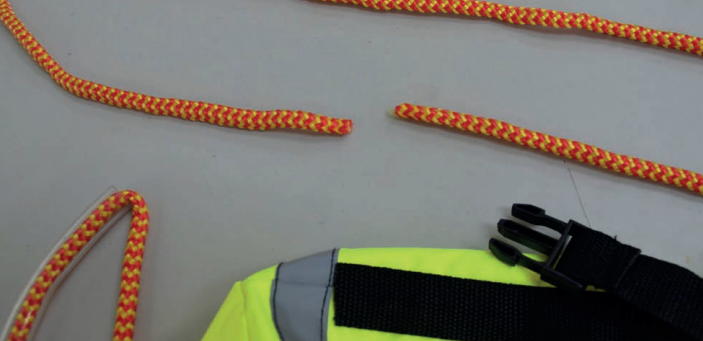The UK MAIB issued a safety warning informing that a defective throw bag rescue line was discovered while Warrington Rowing Club was conducting boat capsize drills for new rowers at Halton Baths in Cheshire, UK. A 15m long polypropylene rescue line in a throw bag parted while a young person in the water was being pulled to the side of the pool during a simulated rescue.
There were no injuries, but the rowing club safety advisor subsequently found another throw bag with a defective rescue line that had been purchased from the same supplier, Riber Products Limited (RIBER).
Upon inspection, the defective throw bag rescue lines were found to have been made up of sections of polypropylene rope fused together, which broke easily at the joint when put under tension.
One line was constructed of two sections of rope fused together, the other was constructed of four sections of rope, resulting in three fused joints in its 15m length. Intact and joined sections of one of the defective rescue lines were tested to determine the line’s minimum breaking load. The intact section failed at 256 kgf and the joined sections failed between 19 and 23 kgf.
RIBER, and several other suppliers of throw bag rescue lines, import the complete manufactured product pre-branded with their company’s logo. The foreign suppliers identified so far assemble the throw bags using components from further suppliers. As the rope used for rescue lines in throw bags is not classified as lifesaving or safety equipment, there is no requirement for it to conform to any recognised safety or quality standards other than the General Product Safety Directive 2001/95/EC, UK MAIB explained.
Many commercial craft and recreational vessels carry throw bag rescue lines as part of their safety equipment, and it is estimated that there are tens of thousands in circulation in the UK alone. It is likely that many of these throw bags will lie dormant in a cupboard or locker until they are required to be deployed in an emergency.
To ensure that throw bag rescue lines are fit for purpose, they should be opened and checked. In particular, UK MAIB advises:
- The entire length of the rescue line should be examined for joins or other discontinuities. This can best be done by feeling along the length of the line with bare hands to identify rough patches or lumps.
- Any knots, splices or other methods of securing the ends of the line to handles, quoits or other parts of the equipment should also be checked for integrity.
- The throw bag should be inspected and tried at regular intervals and repacked according to the manufacturer’s instructions, as otherwise the line may not deploy freely from the bag when required.
- Any throw bag rescue lines found to have joins or discontinuities should be removed from service and the original manufacturer /supplier informed.




























































